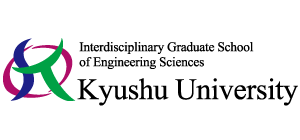検索キーワード:Plasma
[Category Ⅲ] Space Environmental Fluid Dynamics
Department of Earth System Science and Technology
Associate Professor Shuichi MATSUKIYO , Assistant Professor Shogo ISAYAMA,
Labo Site
Space is filled with plasma. In our heliosphere the main source of plasma is the sun. Magnetospheres of planets are connected with the sun via the plasma filling the interplanetary space. Their behaviour is influenced in many ways by solar activity. The heliosphere itself is exposed to interstellar space which is also filled with interstellar plasma... We study a variety of space environments from near Earth to distant high energy objects. We also work to develop the propulsion techniques of spacecraft by controlling plasma.
Physics of collisionless shocks Nonlinear waves and turbulence in space plasma Acceleration and transport of cosmic rays Relativistic plasma High density radiofrequency plasma
[Category II] Electronic Physical Device Engineering
Device Science and Engineering
Professor Tsuyoshi YOSHITAKE , Associate Professor Abdelrahman Zkria , Assistant Professor Hiroshi NARAGINO,
Labo Site
We carry out research on processes and evaluation technologies, including elemental technologies for preparing sensing materials and fabricating devices. Physical vapor deposition methods such as sputtering, laser ablation, and coaxial arc plasma deposition are mainly employed for growing sensing materials in thin film, and we actively employ advanced lasers as new elemental technologies for device formations. Our lab comprises Japanese students coming from other universities and Kosen and foreign students.
● Development of sensors and photovoltaics that operate in extreme environments employing wide gap semiconductors such as diamond and gallium oxide.
● The new process development for forming quantum centers in diamond and their applications to quantum sensors bio-makers
● Spin injection into semiconductors and creation of semiconductor spin devices
[Category II] Nuclear and Radiation Engineering Physics
Plasma and Quantum Science and Engineering
Professor Yukinobu Watanabe , Associate Professor Tadahiro Kin , Assistant Professor Shoichiro Kawase,
Labo Site
"Nuclear and radiation physics engineering research supporting a safe, secure, and smart future society" We are conducting interdisciplinary research related to physics and medicine/engineering with the aim of cutting-edge application of particle beams such as neutrons and muons to the fields of energy, medicine, space development, etc. Using advanced techniques of experiments, theoretical calculations, and numerical simulations, we are intensively studying the mechanisms of cosmic-rays induced soft errors in semiconductor devices, reduction and resource recycling of high-level radioactive wastes through nuclear transmutation, the development of a new radiopharmaceutical manufacturing method used for diagnosis and treatment of cancer, and deterioration diagnosis of small and medium-sized infrastructure equipment with muography technique, and so on.
・Cosmic-rays induced soft errors in semiconductor devices
・Reduction and resource recycling of high-level radioactive wastes through nuclear transmutation
・Structure perspective with advanced muography technique
・Medical RI production with accelerator neutrons
・Development of advanced radiation detectors and data analysis methods
[Category II] Ionized Gas Dynamics Laboratory
Device Science and Engineering
Associate Professor
Yukihiko Yamagata , Associate Professor
Kungen Tsutsui (Teii),
Labo Site
Plasma and laser processing using the advantage of ionized gas dynamics can potentially cause a variety of unique physical/chemical interactions, and is widely used as one of the advanced technologies for supporting sustainable society in various research fields such as electronics, material science, and environmental science. Our group tries to develop next generation technologies by application of plasmas and lasers. These include spectroscopic characterization of optical/electronic device systems, development of new-type optical sources, decomposition of environmental pollutants, development of electronic materials and devices operable under harsh environments, and development of biomedical materials and devices compatible with the human body.
1. Study of plasma and laser processing by laser diagnostics
2. Remote measurement of temperature/strain of semiconductor devices
3. Synthesis of low-k films using DUV pulsed-laser deposition
4. Field emission devices using nanostructured materials
5. Diodes and capacitors using wide band gap semiconductors for high temperature condition
6. Surface functionalization and biological characterization of ultrahard materials
[Category II] Energy Chemical Engineering
Plasma and Quantum Science and Engineering
Associate Professor Kazunari Katayama , Assistant Professor Makoto Oya,
Labo Site
With the aim of developing attractive next-generation energy systems, we are engaged in education and research in the fields of chemical engineering such as process engineering and thermal mass transfer engineering. Through fundamental experiments, we try to model chemical reactions and mass transfer phenomena, and then to use numerical simulations to pursue optimal systems. In the development area of most advanced science and technology, there are many situations in which it is difficult to predict phenomena based on just conventional knowledge.In our laboratory, we are challenging to correctly understand and model mass transfer phenomena occuring in special environments such as the interface between plasma or supercritical CO2 and solid walls, the flow field of high-temperature melts (liquid metals and molten salts), and the field of nuclear transmutation reaction by neutrons. Additonally, we are also actively studying on the hydrogen production using solid electrolyte cell or plasma, and environmental dynamics of tritium, which is a radioactive hydrogen isotope. These scientific achievements will be useful for the realization of nuclear fusion reactors, next-generation fission reactors, and a society utilizing hydrogen energy and renewable energy.
・Development of fuel cycle system in fusion power plants.
・Modeling of tritium mass transfer phenomena in soils and plants
・Development of liquid metal and molten salt circulation system
・Development of hydrogen production / extraction technology using plasma, solid electrolytic cells, etc.
